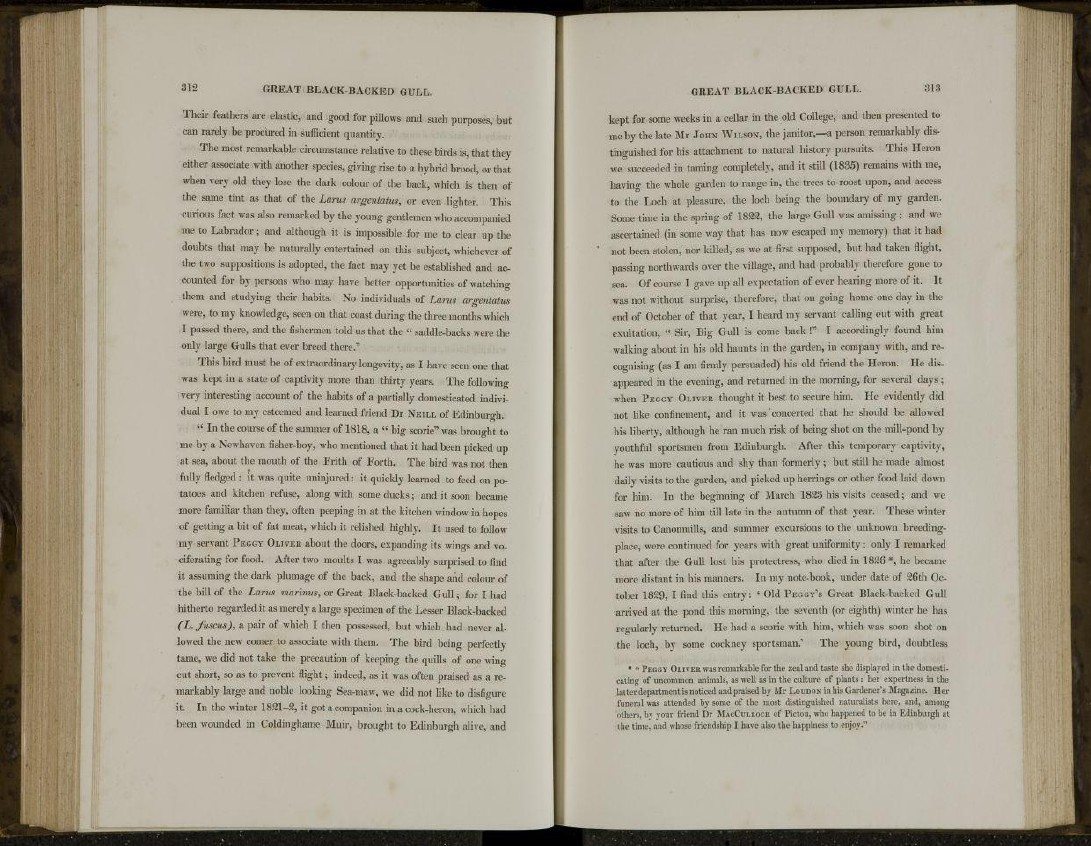
Their feathers are elastic, and good for pillows and such purposes, but
can rarely be procured in sufficient quantity.
The most remarkable circumstance relative to these birds is, that they
either associate with another species, giving rise to a hybrid brood, or that
when very old they lose the dark colour of the back, which is then of
the same tint as that of the Larus argentatus, or even lighter. This
curious fact was also remarked by the young gentlemen who accompanied
me to Labrador; and although it is impossible for me to clear up the
doubts that may be naturally entertained on this subject, whichever of
the two suppositions is adopted, the fact may yet be established and accounted
for by persons who may have better opportunities of watching
them and studying their habits. No individuals of Larus argentatus
were, to my knowledge, seen on that coast during the three months which
I passed there, and the fishermen told us that the " saddle-backs were the
only large Gulls that ever breed there."
This bird must be of extraordinary longevity, as I have seen one that
was kept in a state of captivity more than thirty years. The following
very interesting account of the habits of a partially domesticated individual
I owe to my esteemed and learned friend Dr NEILL of Edinburgh.
*{ In the course of the summer of 1818, a " big scorie" was brought to
me by a Newhaven fisher-boy, who mentioned that it had been picked up
at sea, about the mouth of the Frith of Forth. The bird was not then
fully fledged : it was quite uninj ured: it quickly learned to feed on potatoes
and kitchen refuse, along with some ducks; and it soon became
more familiar than they, often peeping in at the kitchen window in hopes
of getting a bit of fat meat, which it relished highly. It used to follow
my servant PEGGY OLIVER about the doors, expanding its wings and vociferating
for food. After two moults 1 was agreeably surprised to find
it assuming the dark plumage of the back, and the shape and colour of
the bill of the Larus marinus, or Great Black-backed Gull; for I had
hitherto regarded it as merely a large specimen of the Lesser Black-backed
(L. Juscus), a pair of which I then possessed, but which had never allowed
the new comer to associate with them. The bird being perfectly
tame, we did not take the precaution of keeping the quills of one wingcut
short, so as to prevent flight; indeed, as it was often praised as a remarkably
large and noble looking Sea-maw, we did not like to disfigure
it. In the winter 1821-2, it got a companion in a cock-heron, which had
been wounded in Coldinghame Muir, brought to Edinburgh alive, and
kept for some weeks in a cellar in the old College, and then presented to
me by the late Mr JOHN WILSON, the janitor,—a person remarkably distinguished
for his attachment to natural history pursuits. This Heron
we succeeded in taming completely, and it still (1835) remains with me,
having the whole garden to range in, the trees to roost upon, and access
to the Loch at pleasure, the loch being the boundary of my garden.
Some time in the spring of 1822, the large Gull was amissing ; and we
ascertained (in some way that has now escaped my memory) that it had
not been stolen, nor killed, as we at first supposed, but had taken flight,
passing northwards over the village, and had probably therefore gone to
sea. Of course I gave up all expectation of ever hearing more of it. It
was not without surprise, therefore, that on going home one day in the
end of October of that year, I heard my servant calling out with great
exultation, " Sir, Big Gull is come back !" I accordingly found him
walking about in his old haunts in the garden, in company with, and recognising
(as I am firmly persuaded) his old friend the Heron. He disappeared
in the evening, and returned in the morning, for several days;
when PEGGY OLIVER thought it best to secure him. He evidently did
not like confinement, and it was concerted that he should be allowed
his liberty, although he ran much risk of being shot on the mill-pond by
youthful sportsmen from Edinburgh. After this temporary captivity,
he was more cautious and shy than formerly ; but still he made almost
daily visits to the garden, and picked up herrings or other food laid down
for him. In the beginning of March 1823 his visits ceased; and we
saw no more of him till late in the autumn of that year. These winter
visits to Canonmills, and summer excursions to the unknown breedingplace,
were continued for years with great uniformity : only I remarked
that after the Gull lost his protectress, who died in 1828 *, he became
more distant in his manners. In my note-book, under date of 26th October
1829, I find this entry: < Old PEGGY'S Great Black-backed Gull
arrived at the pond this morning, the seventh (or eighth) winter he has
regularly returned. He had a scorie with him, which was soon shot on
the loch, by some cockney sportsman.' The young bird, doubtless
" " PEGGY OLIVER was remarkable for the zeal and taste she displayed in the domesticating
of uncommon animals, as well as in the culture of plants : her experlness in the
lalter department is noticed and praised by Mr LOUDON in his Gardener's Magazine. Her
funeral was attended by some of the most distinguished naturalists here, and, among
others, by your friend Dr MACCULLOCH of Pictou, who happened to be in Edinburgh at
the time, and whose friendship I have also the happiness to enjoy."